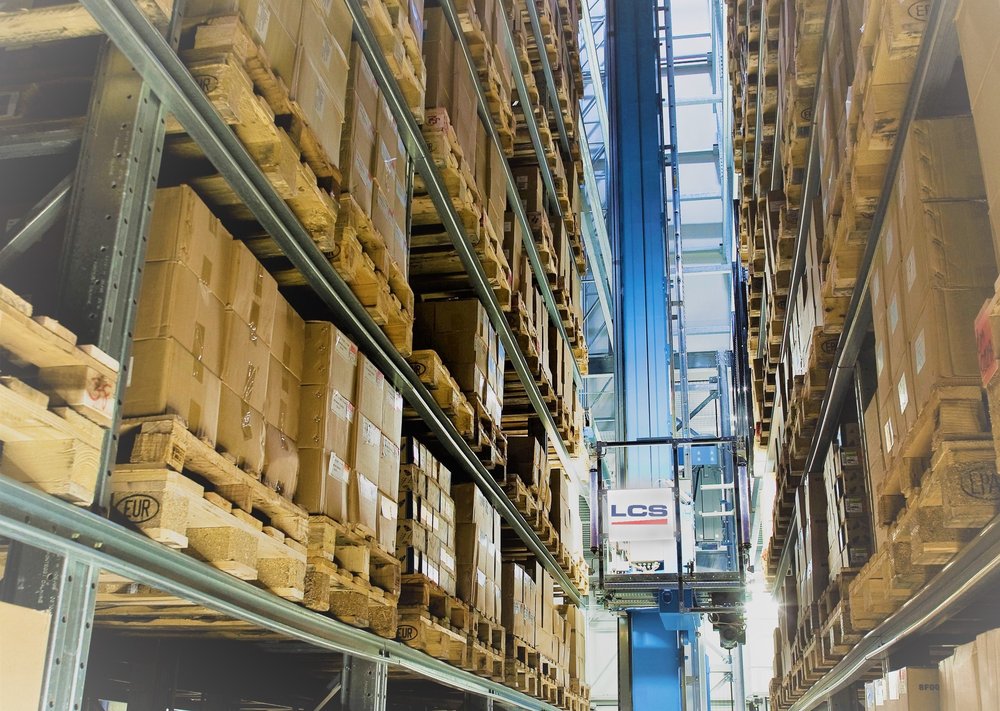Automatic warehouses are logistic plants thanks to which operations such as the receipt and storage of goods, the preparation of orders and shipments are carried out in conditions of maximum safety and speed. These are strategic elements in the context of the supply chain, which give value to the companies that use them. Automation, in fact, offers a more efficient service and guarantees an improvement in productivity. Semi-automatic warehouses, on the other hand, provide for a lower degree of automation, leaving room for human operations as well.
AUTOMATIC WAREHOUSE
They are systems that operate with the concept of “goods to man”. They are managed through a warehouse software and can be self-supporting (walls and roofs fixed to the shelving) or installed inside a building.
Based on the type of goods handled, a distinction is made between automatic warehouses for containers / trays or for pallets / metal cages: in the first case they are warehouses that use miniload type stacker cranes and can reach heights of 20 meters while in the second case heights of 40 meters.
The selectivity within a shelving can be single, double or multiple. Selectivity translates into the number of Loading Units (containers / pallets that are stored deep in the shelving).
Another type of automatic warehouses are vertical and horizontal warehouses.
The vertical warehouses can be of the “rotating” type or with trays; they develop vertically and ensure quick access to the deposited materials. As for the “rotators”, the various shelves that make up the carousel rotate in both directions in the machine vertically, so that the stored goods can be brought with the fastest route to the special collection position. The cabinets of the vertical warehouses are closed, they can reach heights of 20 meters, they can be self-supporting or not and reach widths of about 4 meters.
The horizontal warehouses are the same as the vertical ones, with the exception of the rotation axis which is horizontal and not vertical. They use baskets with different shelves that rotate in both directions. These are systems recommended in contexts where there are limitations in the sense of height.
STRENGTHS AND WEAKNESSES OF AN AUTOMATIC WAREHOUSE
An automatic warehouse helps to ensure an overall increase in the level of service and to reduce errors from the point of view of management and the material handling. This is due to the fact that fewer workers are used for heavy and repetitive tasks.
The smaller space occupied, then, translates into a decrease in costs: in fact an automatic warehouse occupies a proportionally smaller surface than a traditional one, because it tends to develop in height.
Furthermore, the optimized logistic performance generates fast, punctual and complete deliveries.
The defects? Few, but it is worth knowing them: for example, designing an automated warehouse is not easy, and its structure is not easy to change over time. An automated warehouse requires a considerable initial investment, which is compensated by the fact that labor costs decrease significantly. In any case, the automation of the logistics warehouse is essential to eliminate unnecessary costs and to increase the overall safety levels, both for goods and for workers.

SEMI-AUTOMATIC WAREHOUSE
A semi-automatic warehouse guarantees not total but only partial process automation. The difference with respect to automatic warehouses lies in the fact that most of the operation is still up to the warehouse employees, who are guided in their activities by software and hardware technologies.
As in the case of an Automatic Warehouse, therefore, the management is entrusted to a Warehouse Management System software, which is used to optimize the various warehouse processes, including the shipment of goods.
A particular type of semi-automatic warehouse is represented by the “pick to light” systems for the fast picking of goods.
Another type of semi-automatic warehouse are the compactable warehouses, which use mobile trolleys to move the shelving; the use of the spaces is optimal as it opens one aisle at a time. These warehouses are ideal for high-stock goods with a medium-low turnover rate.
STRENGTHS AND WEAKNESSES OF A SEMI-AUTOMATIC WAREHOUSE
Automating storage and picking procedures (but not only, of course) is also possible with a semi-automatic warehouse, which in turn helps to reduce process times so as to favor greater productivity.
Semi-automatic warehouses are more technologically advanced than traditional warehouses; however for the purposes of disengagement of the operations they still require manpower. A possible defect of semi-automatic warehouses can be identified precisely in the fact that the human component is always potentially subject to errors: but fortunately the management system allows them to be reduced as much as possible.
We are dealing with an intermediate level of automation: this means that semi-automatic warehouses are able to increase productivity and have a lower cost than a complete automation solution.
WHEN TO CHOOSE AN AUTOMATIC AND A SEMI-AUTOMATIC WAREHOUSE.
There are no precise rules. The optimal solution depends on the project data which are fundamental in the choice of the solution, on the type of goods handled and on the spaces available.
The management of an automatic warehouse is efficient and optimized: for this reason, if the budget available and the ROI allow it, it is always worthwhile to focus on an automatic warehouse, which looks like a cutting-edge structure from a technological point of view, thanks to which handling operations can be speeded up, considerably reducing errors.
However, even some semi-automatic systems find important applications in many contexts including the world of e-commerce.
LCS AUTOMATIC WAREHOUSE
LCS automatic warehouses are designed to optimize intralogistics processes and, consequently, contribute to improving company competitiveness. If you want to know them more closely, but also discover the benefits that these solutions are able to guarantee, contact us for personalized advice, you will get all the information you need.



